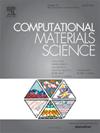Hydrogen and water interactions with CrMnFeCoNi alloy from density functional theory calculations
IF 3.1
3区 材料科学
Q2 MATERIALS SCIENCE, MULTIDISCIPLINARY
引用次数: 0
Abstract
High entropy alloys (HEAs) are a promising class of materials with remarkable mechanical and catalytic properties. Among these, the quinary CrMnFeCoNi alloy (also called “Cantor alloy”) has attracted considerable attention given its thermodynamic stability and remarkable mechanical properties under different temperatures. Given that various degradation mechanisms involve multiple contaminants, such as hydrogen and water in hydrogen embrittlement and surface poisoning, respectively, understanding their interactions with the Cantor alloy is critical for its practical applications as structural, nuclear, or hydrogen storage material. In this work, we perform first-principles calculations based on Density Functional Theory (DFT) to investigate such interactions when considering various microstructures, including bulk materials and those containing certain defects, such as grain boundaries, stacking faults, and vacancies. We also employ Global Sensitivity Analysis to identify the importance of different factors in the stability of the impurities. We find that the accuracy of the H formation energy is significantly affected by spin polarization and chemical short-range order. The study also identifies a strong tendency for hydrogen interstitials to segregate to Σ5(210)/[001] symmetric tilt grain boundary, even when H concentrations are high, suggesting that a certain type of grain boundaries acts as H sinks within the alloy. This result is reinforced by the low formation energy of vacancy-hydrogen complexes, which can contain multiple hydrogen atoms. Finally, the surface reactivity analysis reveals that the adsorption energy of oxygen and hydroxyl groups is highly sensitive to the specific metal atom involved in the binding, with a clear preference for chromium atoms, which could have implications for the alloy’s oxidation and corrosion behavior.

求助全文
约1分钟内获得全文
求助全文
来源期刊

Computational Materials Science
工程技术-材料科学:综合
CiteScore
6.50
自引率
6.10%
发文量
665
审稿时长
26 days
期刊介绍:
The goal of Computational Materials Science is to report on results that provide new or unique insights into, or significantly expand our understanding of, the properties of materials or phenomena associated with their design, synthesis, processing, characterization, and utilization. To be relevant to the journal, the results should be applied or applicable to specific material systems that are discussed within the submission.
 求助内容:
求助内容: 应助结果提醒方式:
应助结果提醒方式:


